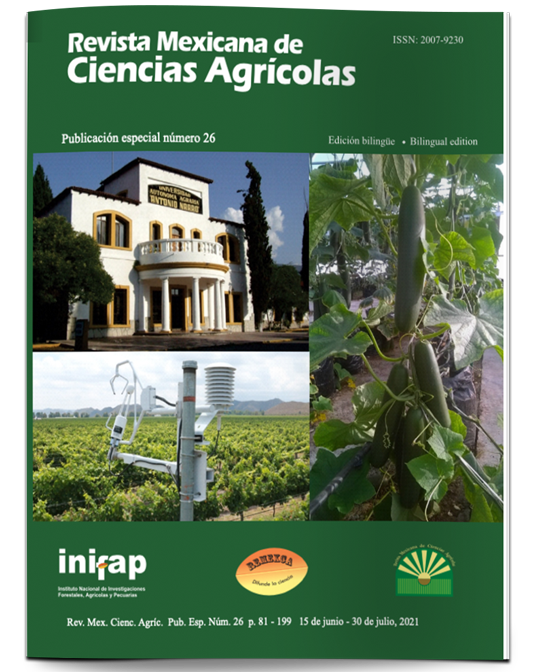Net carbon dioxide exchange rate of a vineyard during the growth cycle
DOI:
https://doi.org/10.29312/remexca.v0i26.2948Keywords:
Viits vinifera L., carbon sequestration, photosynthesis, photosynthetically active radiationAbstract
In addition to harvesting of grape for fresh consumption, juice making and wine production, vineyards (Vitis vinifera L.) for their status as woody and long-lived plants can have an important participation in the assimilation and retention of atmospheric carbon. The objective of this study was to evaluate the net carbon dioxide exchange rate of the ecosystem (NEE) in a vineyard during its production cycle, and its relationship to atmospheric carbon sequestration. The study was carried out (from April to December 2018) in an 11-year-old Shiraz cultivar vineyard in the Vinícola San Lorenzo, Parras, Coahuila. The rate of carbon dioxide flow between the vineyard canopy and the atmosphere, through the months of growth was measured with the sensors of an eddy covariance system. From April to November the vineyard acts as an atmospheric carbon sink and during May, June and July the highest NEE values were obtained, with an average value of -3.014 g C m-2 s-1. The carbon stored in the wood of the vineyard plants was 3.35 t C ha-1. These results show that vineyards are agricultural systems that can have a significant role in mitigating atmospheric carbon dioxide, which, coupled with their status as woody-long-lived plants and the large established areas of vineyards in Mexico and the world, are very important carbon storage ecosystems.
Downloads
Downloads
Published
How to Cite
Issue
Section
License
Copyright (c) 2021 Revista Mexicana de Ciencias Agrícolas

This work is licensed under a Creative Commons Attribution-NonCommercial 4.0 International License.
The authors who publish in Revista Mexicana de Ciencias Agrícolas accept the following conditions:
In accordance with copyright laws, Revista Mexicana de Ciencias Agrícolas recognizes and respects the authors’ moral right and ownership of property rights which will be transferred to the journal for dissemination in open access. Invariably, all the authors have to sign a letter of transfer of property rights and of originality of the article to Instituto Nacional de Investigaciones Forestales, Agrícolas y Pecuarias (INIFAP) [National Institute of Forestry, Agricultural and Livestock Research]. The author(s) must pay a fee for the reception of articles before proceeding to editorial review.
All the texts published by Revista Mexicana de Ciencias Agrícolas —with no exception— are distributed under a Creative Commons License Attribution-NonCommercial 4.0 International (CC BY-NC 4.0), which allows third parties to use the publication as long as the work’s authorship and its first publication in this journal are mentioned.
The author(s) can enter into independent and additional contractual agreements for the nonexclusive distribution of the version of the article published in Revista Mexicana de Ciencias Agrícolas (for example include it into an institutional repository or publish it in a book) as long as it is clearly and explicitly indicated that the work was published for the first time in Revista Mexicana de Ciencias Agrícolas.
For all the above, the authors shall send the Letter-transfer of Property Rights for the first publication duly filled in and signed by the author(s). This form must be sent as a PDF file to: revista_atm@yahoo.com.mx; cienciasagricola@inifap.gob.mx; remexca2017@gmail.
This work is licensed under a Creative Commons Attribution-Noncommercial 4.0 International license.



